8.4: The Logistic Equation
( \newcommand{\kernel}{\mathrm{null}\,}\)
- Describe the concept of environmental carrying capacity in the logistic model of population growth.
- Draw a direction field for a logistic equation and interpret the solution curves.
- Solve a logistic equation and interpret the results.
Differential equations can be used to represent the size of a population as it varies over time. We saw this in an earlier chapter in the section on exponential growth and decay, which is the simplest model. A more realistic model includes other factors that affect the growth of the population. In this section, we study the logistic differential equation and see how it applies to the study of population dynamics in the context of biology.
Population Growth and Carrying Capacity
To model population growth using a differential equation, we first need to introduce some variables and relevant terms. The variable
In Exponential Growth and Decay, we studied the exponential growth and decay of populations and radioactive substances. An example of an exponential growth function is
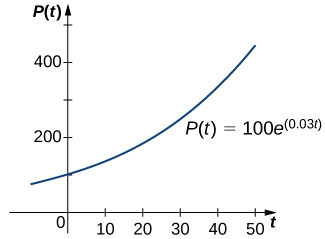
We can verify that the function
with
This differential equation has an interesting interpretation. The left-hand side represents the rate at which the population increases (or decreases). The right-hand side is equal to a positive constant multiplied by the current population. Therefore the differential equation states that the rate at which the population increases is proportional to the population at that point in time. Furthermore, it states that the constant of proportionality never changes.
One problem with this function is its prediction that as time goes on, the population grows without bound. This is unrealistic in a real-world setting. Various factors limit the rate of growth of a particular population, including birth rate, death rate, food supply, predators, and so on. The growth constant
The carrying capacity of an organism in a given environment is defined to be the maximum population of that organism that the environment can sustain indefinitely.
We use the variable
Let
The logistic equation was first published by Pierre Verhulst in
Suppose that the initial population is small relative to the carrying capacity. Then
However, as the population grows, the ratio
Now suppose that the population starts at a value higher than the carrying capacity. Then

This phase line shows that when
Let’s consider the population of white-tailed deer (Odocoileus virginianus) in the state of Kentucky. The Kentucky Department of Fish and Wildlife Resources (KDFWR) sets guidelines for hunting and fishing in the state. Before the hunting season of 2004, it estimated a population of 900,000 deer. Johnson notes: “A deer population that has plenty to eat and is not hunted by humans or other predators will double every three years.” (George Johnson, “The Problem of Exploding Deer Populations Has No Attractive Solutions,” January 12,2001, accessed April 9, 2015)
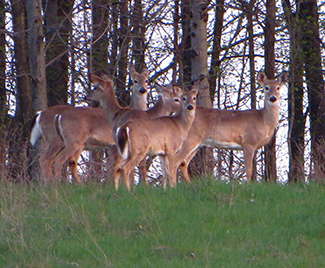
This observation corresponds to a rate of increase
- For this application, we have
- Solve the initial-value problem from part a.
- According to this model, what will be the population in
Suppose the population managed to reach 1,200,000 What does the logistic equation predict will happen to the population in this scenario?
Solution
a. The initial value problem is
b. The logistic equation is an autonomous differential equation, so we can use the method of separation of variables.
Step 1: Setting the right-hand side equal to zero gives
Step 2: Rewrite the differential equation and multiply both sides by:
Step 3: Integrate both sides of the equation using partial fraction decomposition:
Step 4: Multiply both sides by 1,072,764 and use the quotient rule for logarithms:
Here
Here
Step 5: To determine the value of
The initial condition is
Therefore
Dividing the numerator and denominator by 25,000 gives
Figure
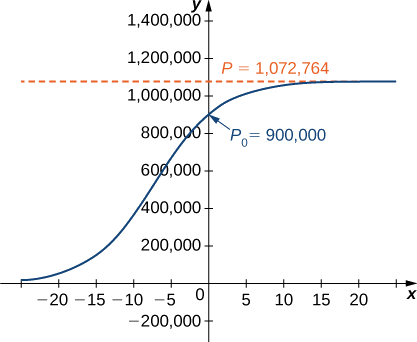
c. Using this model we can predict the population in 3 years.
This is far short of twice the initial population of
d. If the population reached 1,200,000 deer, then the new initial-value problem would be
The general solution to the differential equation would remain the same.
To determine the value of the constant, return to the equation
Substituting the values
Therefore
This equation is graphed in Figure
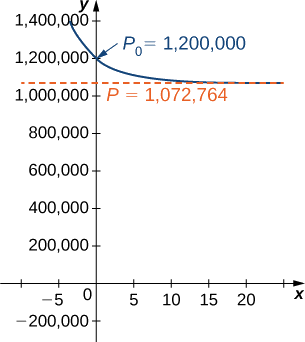
Solving the Logistic Differential Equation
The logistic differential equation is an autonomous differential equation, so we can use separation of variables to find the general solution, as we just did in Example
Step 1: Setting the right-hand side equal to zero leads to
Step 2: Rewrite the differential equation in the form
Then multiply both sides by
Multiply both sides of the equation by
The left-hand side of this equation can be integrated using partial fraction decomposition. We leave it to you to verify that
Then the Equation
Now exponentiate both sides of the equation to eliminate the natural logarithm:
We define
To solve this equation for
Next, factor
The last step is to determine the value of
Finally, substitute the expression for
Now multiply the numerator and denominator of the right-hand side by
We state this result as a theorem.
Consider the logistic differential equation subject to an initial population of
Now that we have the solution to the initial-value problem, we can choose values for
Dividing top and bottom by
This is the same as the original solution. The graph of this solution is shown again in blue in Figure
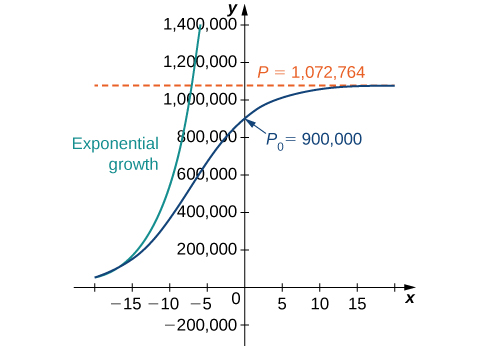
Working under the assumption that the population grows according to the logistic differential equation, this graph predicts that approximately
The solution to the logistic differential equation has a point of inflection. To find this point, set the second derivative equal to zero:
Setting the numerator equal to zero,
As long as
Solving for
Notice that if
A population of rabbits in a meadow is observed to be
- Write the logistic differential equation and initial condition for this model.
- Draw a slope field for this logistic differential equation, and sketch the solution corresponding to an initial population of
- Solve the initial-value problem for
- Use the solution to predict the population after
- Hint
-
First determine the values of
- Answer
-
a.
b.
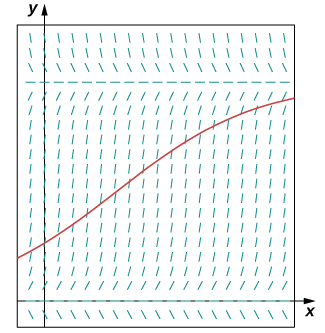
c.
d. After
An improvement to the logistic model includes a threshold population. The threshold population is defined to be the minimum population that is necessary for the species to survive. We use the variable
where
- The threshold population is useful to biologists and can be utilized to determine whether a given species should be placed on the endangered list. A group of Australian researchers say they have determined the threshold population for any species to survive:
- Draw the direction field for the differential equation from step
- What is the limiting population for each initial population you chose in step
- This equation can be solved using the method of separation of variables. However, it is very difficult to get the solution as an explicit function of
Key Concepts
- When studying population functions, different assumptions—such as exponential growth, logistic growth, or threshold population—lead to different rates of growth.
- The logistic differential equation incorporates the concept of a carrying capacity. This value is a limiting value on the population for any given environment.
- The logistic differential equation can be solved for any positive growth rate, initial population, and carrying capacity.
Key Equations
- Logistic differential equation and initial-value problem
- Solution to the logistic differential equation/initial-value problem
- Threshold population model
Glossary
- carrying capacity
- the maximum population of an organism that the environment can sustain indefinitely
- growth rate
- the constant
- initial population
- the population at time
- logistic differential equation
- a differential equation that incorporates the carrying capacity
- phase line
- a visual representation of the behavior of solutions to an autonomous differential equation subject to various initial conditions
- threshold population
- the minimum population that is necessary for a species to survive


